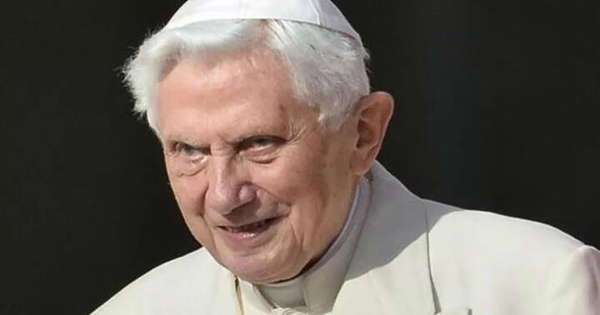Pope, who resigned from his duty in a rare way in history: Who is Pope Benedict XVI?
Former Pope Benedict XVI was buried in the Vatican with a historic funeral. His successor, the current Pope Francesco, led the funeral held in St. Peter's Square for Benedictus, who died on December 31 at the age of 95.

Since Benedict XVI was the first pope to resign in centuries, today's burial marks the first time in modern times that an incumbent pope has led the funeral of his predecessor. Tens of thousands of people gathered in the square to watch the ceremony. Although dozens of state leaders from around the world were invited to the funerals of popes in the past, Benedict XVI was sent off with a relatively simple ceremony as he died after leaving the papacy.
Only delegations from Italy, including the Vatican, and Germany, the hometown of the former pope, were officially invited to the funeral. On the other hand, Queen Sofia of Spain, King Philippe of Belgium, Queen Mathilde, and state leaders from countries such as Hungary, Poland, Portugal, and Slovenia attended the ceremony in a special capacity.
THEY WILL BE PLACED IN 3 SEPARATE COATS INCLUDED
After the ceremony, the body of the former Pope will be buried in one of the burial chambers on the lower floor of St. Peter's Basilica in the Vatican. According to tradition, the body will be placed in 3 separate coffins, which will be closed with special strips and seals. Coins and medals minted during the 16th Benedict era, the old pope's palliums, and a text describing his life will also be placed on the coffin.
Benedict's body was open to the public in the basilica from last Monday until today's funeral. According to the Vatican's statement, about 200,000 people visited the ex-pope in the catafalque in 3 days.
Benedict, who was elected to the papacy in 2005 at the age of 78, decided to resign in 2013 on the grounds that his administrative capacity had decreased due to his advancing age. With this decision, he went down in history as the first person in 600 years to break the tradition of popes staying in office until their death. For this reason, Benedict XVI is also known as a revolutionary in the Catholic Church, even though he was a hardline conservative leader.
THE PERCEPTION OF 'TWO POPES' IN THE CATHOLIC CHURCH
There has been an extraordinary period in the Catholic Church in recent years, as Benedict the 16th chose to live in the Vatican and dress in white colors special to the popes after his resignation. Although the former pope, who retreated to a monastery, remained silent in general, he also caused a 'double-headed' image in the church administration with his occasional departures.
Argentine Pope Francesco, one of the rare popes elected outside of Europe, faced the reaction of the conservative wing within the church with some of the steps he took after he took office in 2013, and this group continued to refer to the retired Pope Benedict XVI.
The actions of the new Pope against performing the rites in Latin and the abolition of the celibacy requirement for priests in the Amazons were among the initiatives to which the conservative wing reacted most clearly. Benedict 16th also strengthened the perception of "two popes" by personally getting involved in these issues.
Monsignor Georg Ganswein, his personal secretary, who is one of the closest names to Benedict XVI, told the Tagespost newspaper published in Germany earlier this week that Pope Francis' decision to impose restrictions on Latin liturgies "broke the heart" of the retired pope.
Who?
Former Pope Benedict XVI died at the age of 95. Benedict XVI, whose name before becoming Pope was Joseph Alois Ratzinger, was born on April 16, 1927, in Marktl am Inn, Passau, Germany. Ratzinger, who studied philosophy and theology, worked as an academician at different universities in Germany since 1959.
AGCA'S PAPA INVESTIGATION
He was appointed Cardinal of Munich by the Pope in 1977. Pope II in 1981. It was brought to Rome by John Paul. On November 25, 1981, he was appointed Chairman of the Religious Doctrines Board, one of the most important institutions in the Vatican. Ratzinger held that post for 24 years until the Pope passed away. In 1981, Pope II. He was the chairman of the investigation committee investigating the assassination attempt on John Paul by Mehmet Ali Ağca.
Ratzinger, who normally should have been retired as he turned 75 in 2002, was left on the Pope's special order. Ratzinger, who was the chairman of many important boards and commissions beside the Presidency of the Religious Doctrines Board in the Vatican, also served as the chairman of the Papal Biblical Commission and also of the Papal International Theological Commission. Ratzinger was given the title of Diocesan in 2002 and was also elected President of the Conclave.
He was declared the new Pope on 19 April 2005. It is stated that the new Pope will use the name, Benedict XVI. Benedict was 78 years old when he was elected Pope, making him the oldest pope elected since 1730.
PRAYED AT SULTANAHMET (Blue Mosque)
Pope Benedict, who visited Turkey in 2006, arrived in Ankara on 27 November. He visited the Virgin Mary's House near Ephesus on 29 November. Later, the Pope, who went to Istanbul, visited Hagia Sophia and the Blue Mosque, accompanied by art historian Sedat Bornovalı, on 30 November. Pope Benedict, Pope II. He was the second Pope to visit a mosque after John Paul. He prayed at the altar of the Blue Mosque with Mustafa Çağrıcı, the Mufti of Istanbul at the time.
